Restrained Shrinkage Cracking of Fiber-Reinforced High-Strength Concrete
Abstract
:1. Introduction
2. Experimental Program
2.1. Materials
2.2. Concrete Mixtures
2.3. Testing Procedure
3. Results and Discussion
3.1. Fresh Concrete Workability
3.2. Compressive Strength
3.3. Flexural Strength
3.4. Shrinkage
4. Conclusions
- The presence of fibers at mixing time causes balling in fresh concrete and a relative drop of strength in hardened concrete at long-term periods. The addition of fibers caused an increase in the compressive strength at ages of 3, 7, and 28 days up to 16%, 20%, and 3%, respectively.
- Among concrete mixtures, only steel-fiber-containing specimens under bending exhibited post-crack behavior, such that toughness indexes of I5 and I110 were 4.1 and 7.7, respectively, with a residual stress of 0.75 MPa.
- The addition of fibers to concrete mixtures increased cracking age and decreased crack width. Comparison between shrinkage results showed that fibers with high stiffness (high flexural strength), such as steel or glass fibers, exhibited good performance in providing flexural strength, but they underperform relatively in terms of rate and time of restrained shrinkage cracking. Therefore, fibers such as steel, glass, and basalt are not recommended for restraining early age cracking, so that they cause an increased crack width and a decreased cracking age. Polyolefin and polypropylene fibers exhibit good performance in restraining shrinkage at early ages.
- Two types of cracks were observed in concrete rings: (1) full-depth cracks and (2) superficial cracks. Over 28 days, cracks generated on concrete ring surfaces developed into full-depth cracks; nevertheless, in polypropylene-fiber-containing mixtures, no signs of full-depth cracks were observed. Polypropylene-fiber-containing mixtures had the lowest crack width, causing an 84% decreased crack width as well as a 62% increased cracking age.
Author Contributions
Conflicts of Interest
References
- Aggarwal, Y.; Siddique, R. Microstructure and properties of concrete using bottom ash and waste foundry sand as partial replacement of fine aggregates. Constr. Build. Mater. 2014, 54, 210–223. [Google Scholar] [CrossRef]
- Sadrmomtazi, A.; Tahmouresi, B.; Kohani Khoshkbijari, R. Effect of fly ash and silica fume on transition zone, pore structure and permeability of concrete. Mag. Concr. Res. 2017, 1–14. [Google Scholar] [CrossRef]
- Mehrinejad Khotbehsara, M.; Mohseni, E.; Ozbakkaloglu, T.; Ranjbar, M.M. Durability Characteristics of Self-Compacting Concrete Incorporating Pumice and Metakaolin. J. Mater. Civ. Eng. 2017, 29, 04017218. [Google Scholar] [CrossRef]
- Johari, M.M.; Brooks, J.J.; Kabir, S.; Rivard, P. Influence of supplementary cementitious materials on engineering properties of high strength concrete. Constr. Build. Mater. 2011, 25, 2639–2648. [Google Scholar] [CrossRef]
- Naseri, F.; Jafari, F.; Mohseni, E.; Tang, W.; Feizbakhsh, A.; Khatibinia, M. Experimental observations and SVM-based prediction of properties of polypropylene fibres reinforced self-compacting composites incorporating nano-CuO. Constr. Build. Mater. 2017, 143, 589–598. [Google Scholar] [CrossRef]
- Mohseni, E.; Yazdi, M.A.; Miyandehi, B.M.; Zadshir, M.; Ranjbar, M.M. Combined Effects of Metakaolin, Rice Husk Ash, and Polypropylene Fiber on the Engineering Properties and Microstructure of Mortar. J. Mater. Civ. Eng. 2017, 29, 04017025. [Google Scholar] [CrossRef]
- Kwon, M.; Seo, H.; Kim, J. Seismic performance of RC-column wrapped with Velcro. Struct. Eng. Mech. 2016, 58, 379–395. [Google Scholar] [CrossRef]
- Mohseni, E.; Tang, W.; Cui, H. Chloride Diffusion and Acid Resistance of Concrete Containing Zeolite and Tuff as Partial Replacements of Cement and Sand. Materials 2017, 10, 372. [Google Scholar] [CrossRef] [PubMed]
- Triantafyllou, G.G.; Rousakis, T.C.; Karabinis, A.I. Corroded RC beams patch repaired and strengthened in flexure with fiber-reinforced polymer laminates. Compos. Part B-Eng. 2017, 112, 125–136. [Google Scholar] [CrossRef]
- Triantafyllou, G.G.; Rousakis, T.C.; Karabinis, A.I. Effect of patch repair and strengthening with EBR and NSM CFRP laminates for RC beams with low, medium and heavy corrosion. Compos. Part B-Eng. 2018, 133, 101–111. [Google Scholar] [CrossRef]
- Rousakis, T.C.; Tourtouras, I.S. Modeling of passive and active external confinement of RC columns with elastic material. ZAMM-J. Appl. Math. Mech./Z. Angew. Math. Mech. 2015, 95, 1046–1057. [Google Scholar] [CrossRef]
- Iqbal, S.; Ali, A.; Holschemacher, K.; Bier, T.A. Mechanical properties of steel fiber reinforced high strength lightweight self-compacting concrete (SHLSCC). Constr. Build. Mater. 2015, 98, 325–333. [Google Scholar] [CrossRef]
- Hannawi, K.; Bian, H.; Prince-Agbodjan, W.; Raghavan, B. Effect of different types of fibers on the microstructure and the mechanical behavior of Ultra-High Performance Fiber-Reinforced Concretes. Compos. Part B-Eng. 2016, 86, 214–220. [Google Scholar] [CrossRef] [Green Version]
- Zhang, P.; Li, Q.F. Effect of polypropylene fiber on durability of concrete composite containing fly ash and silica fume. Compos. Part B-Eng. 2013, 45, 1587–1594. [Google Scholar] [CrossRef]
- Ghanei, A.; Jafari, F.; Mehrinejad Khotbehsara, M.; Mohseni, E.; Tang, W.; Cui, H. Effect of Nano-CuO on Engineering and Microstructure Properties of Fibre-Reinforced Mortars Incorporating Metakaolin: Experimental and Numerical Studies. Materials 2017, 10, 1215. [Google Scholar] [CrossRef]
- Husem, M. The effects of high temperature on compressive and flexural strengths of ordinary and high-performance concrete. Fire Saf. J. 2006, 41, 155–163. [Google Scholar] [CrossRef]
- Mohseni, E.; Khotbehsara, M.M.; Naseri, F.; Monazami, M.; Sarker, P. Polypropylene fiber reinforced cement mortars containing rice husk ash and nano-alumina. Constr. Build. Mater. 2016, 111, 429–439. [Google Scholar] [CrossRef]
- Kodur, V.K.R.; Cheng, F.P.; Wang, T.C.; Sultan, M.A. Effect of strength and fiber reinforcement on fire resistance of high-strength concrete columns. J. Struct. Eng. 2003, 129, 253–259. [Google Scholar] [CrossRef]
- Sadrmomtazi, A.; Tahmouresi, B.; Saradar, A. Effects of silica fume on mechanical strength and microstructure of basalt fiber reinforced cementitious composites (BFRCC). Constr. Build. Mater. 2018, 162, 321–333. [Google Scholar] [CrossRef]
- Afroughsabet, V.; Biolzi, L.; Ozbakkaloglu, T. Influence of double hooked-end steel fibers and slag on mechanical and durability properties of high performance recycled aggregate concrete. Compos. Struct. 2017, 181, 273–284. [Google Scholar] [CrossRef]
- Martinelli, E.; Caggiano, A.; Xargay, H. An experimental study on the post-cracking behavior of Hybrid Industrial/Recycled Steel Fibre-Reinforced Concrete. Constr. Build. Mater. 2015, 94, 290–298. [Google Scholar] [CrossRef]
- Mohseni, E.; Saadati, R.; Kordbacheh, N.; Parpinchi, Z.S.; Tang, W. Engineering and microstructural assessment of fibre-reinforced self-compacting concrete containing recycled coarse aggregate. J. Clean. Prod. 2017, 168, 605–613. [Google Scholar] [CrossRef]
- Rousakis, T.C. Reusable and recyclable nonbonded composite tapes and ropes for concrete columns confinement. Compos. Part B-Eng. 2016, 103, 15–22. [Google Scholar] [CrossRef]
- Gesoğlu, M.; Özturan, T.; Güneyisi, E. Effects of cold-bonded fly ash aggregate properties on the shrinkage cracking of lightweight concretes. Cem. Concr. Compos. 2006, 28, 598–605. [Google Scholar] [CrossRef]
- Darwish, F.A.; Oliveira, T.M.; Coura, C.G.; Kitamura, S.; Barbosa, M.T.G.; Santos, W. Influence of Fiber Ratio in the Size Effect. In Proceedings of the International Conference Concrete: Construction’s Sustainable Option, Dundee, UK, 8–10 July 2008; pp. 123–130. [Google Scholar]
- Vandewalle, L. Hybrid Fiber Reinforced Concrete. In Measuring, Monitoring and Modeling Concrete Properties; Springer: Dordrecht, The Netherlands, 2006; pp. 77–82. [Google Scholar] [CrossRef]
- Beglarigale, A.; Yazıcı, H. Pull-out behavior of steel fiber embedded in flowable RPC and ordinary mortar. Constr. Build. Mater. 2015, 75, 255–265. [Google Scholar] [CrossRef]
- Toledo Filho, R.D.; Ghavami, K.; Sanjuán, M.A.; England, G.L. Free, restrained and drying shrinkage of cement mortar composites reinforced with vegetable fibres. Cem. Concr. Compos. 2005, 27, 537–546. [Google Scholar] [CrossRef]
- Kakooei, S.; Akil, H.M.; Jamshidi, M.; Rouhi, J. The effects of polypropylene fibers on the properties of reinforced concrete structures. Constr. Build. Mater. 2012, 27, 73–77. [Google Scholar] [CrossRef]
- Saje, D.; Bandelj, B.; Šušteršič, J.; Lopatič, J.; Saje, F. Shrinkage of polypropylene fiber-reinforced high-performance concrete. J. Mater. Civ. Eng. 2010, 23, 941–952. [Google Scholar] [CrossRef]
- Yousefieh, N.; Joshaghani, A.; Hajibandeh, E.; Shekarchi, M. Influence of fibers on drying shrinkage in restrained concrete. Constr. Build. Mater. 2017, 148, 833–845. [Google Scholar] [CrossRef]
- Mostofinejad, D.; Hatem, N. The effect of polypropylene fibers on cracking caused polyolefin shrinkage and concrete performance. J. Civil. Eng. 2004, 16, 73–86. [Google Scholar]
- Tassew, S.T.; Lubell, A.S. Mechanical properties of glass fiber reinforced ceramic concrete. Constr. Build. Mater. 2014, 51, 215–224. [Google Scholar] [CrossRef]
- Saghi, H.; Delbari, H. The effect of the polyolefin fibers and concrete strength on polyolefin shrinkage cracking in concrete slabs. J. Concr. Res. 2015, 8, 35–46. [Google Scholar]
- Lee, M.S.; Seo, T.S. Prediction method of drying shrinkage crack in reinforced concrete walls. Int. J. Civ. Eng. 2014, 12, 73–81. Available online: http://ijce.iust.ac.ir/article-1-657-en.html (accessed on 1 November 2017).
- Löfgren, I. Fibre-Reinforced Concrete for Industrial Construction—A Fracture Mechanics Approach to Material Testing and Structural Analysis; Chalmers University of Technology: Göteborg, Sweden, 2005; ISBN 91-7291-696-6. [Google Scholar]
- ASTM C150. Standard Specification for Portland Cement; ASTM International: West Conshohocken, PA, USA, 2012. [Google Scholar]
- ASTM C1240. Standard Specification for Silica Fume Used in Cementitious Mixtures; ASTM International: West Conshohocken, PA, USA, 2012. [Google Scholar]
- ASTM C995. Standard Test Method for Time of Flow of Fiber-Reinforced Concrete through Inverted Slump Cone (Withdrawn 2008); ASTM International: West Conshohocken, PA, USA, 2012. [Google Scholar]
- BS EN 12390-3:2009. Testing Hardened Concrete. Compressive Strength of Test Specimens; British Standard Institution: London, UK, 2009. [Google Scholar]
- ASTM C1609. Standard Test Method for Flexural Performance of Fiber-Reinforced Concrete (Using Beam with Third-Point Loading); ASTM International: West Conshohocken, PA, USA, 2012. [Google Scholar]
- Mao, L.; Barnett, S.J. Investigation of toughness of ultra-high performance fibre reinforced concrete (UHPFRC) beam under impact loading. Int. J. Impact Eng. 2017, 99, 26–38. [Google Scholar] [CrossRef]
- ASTM C1581. Standard Test Method for Determining Age at Cracking and Induced Tensile Stress Characteristics of Mortar and Concrete under Restrained Shrinkage; ASTM International: West Conshohocken, PA, USA, 2016. [Google Scholar]

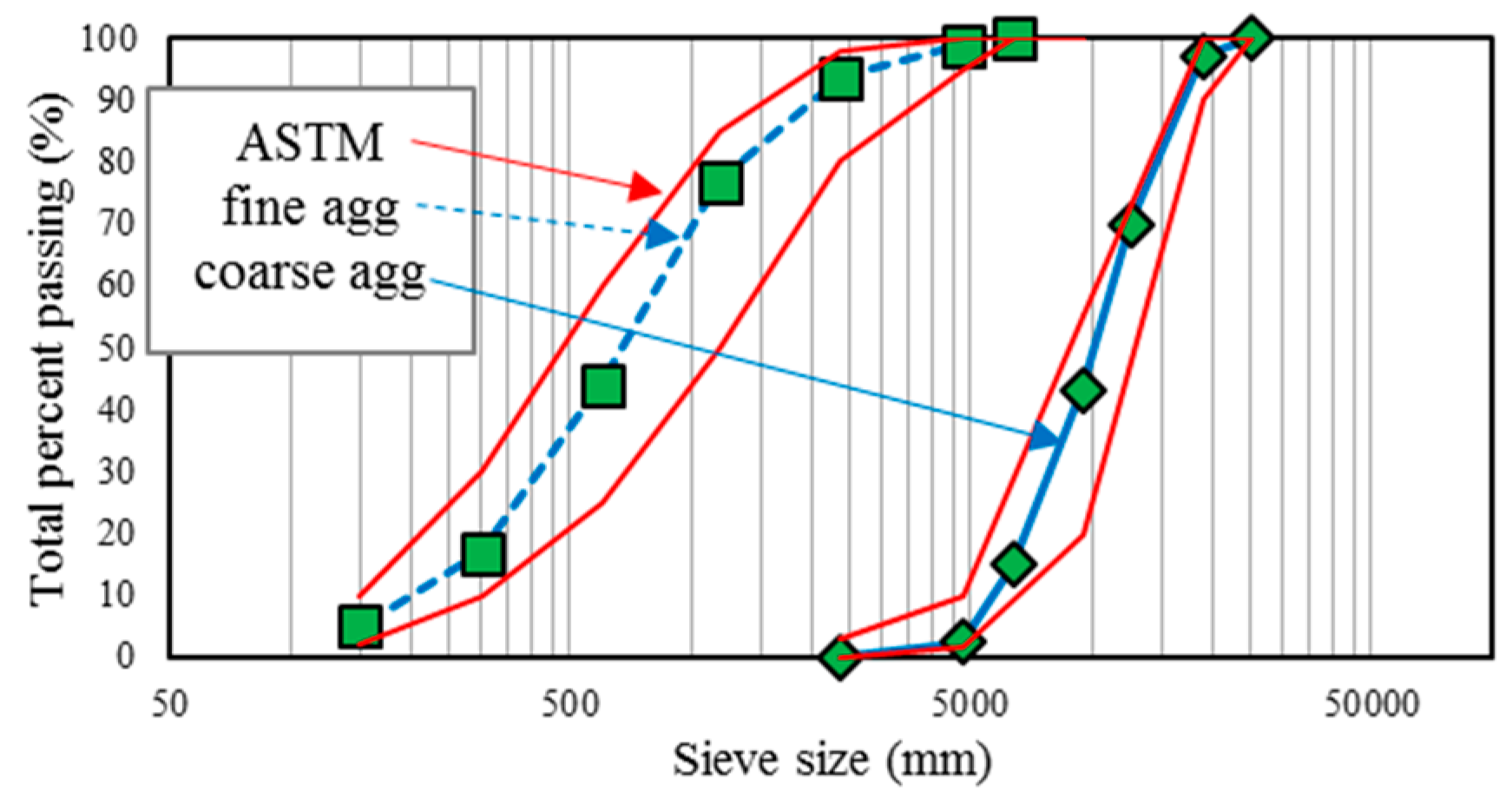
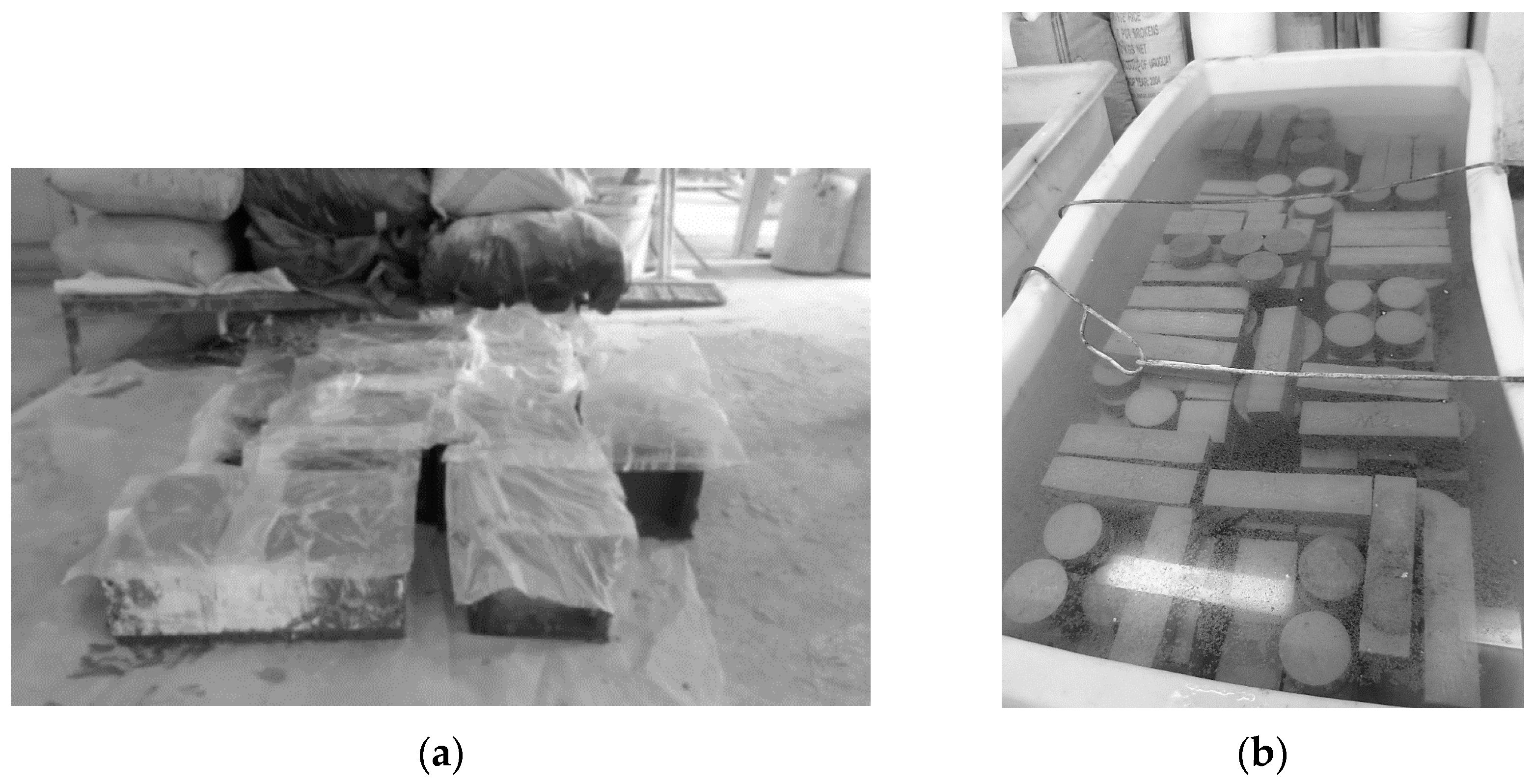
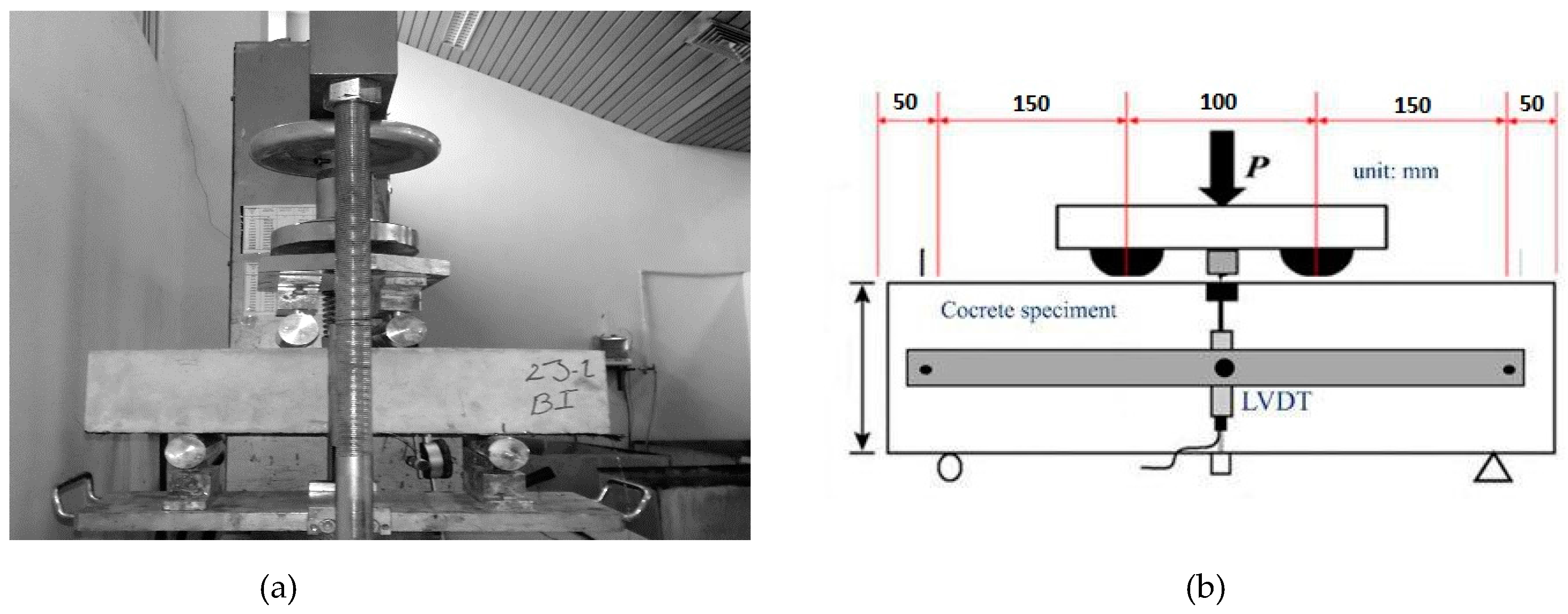

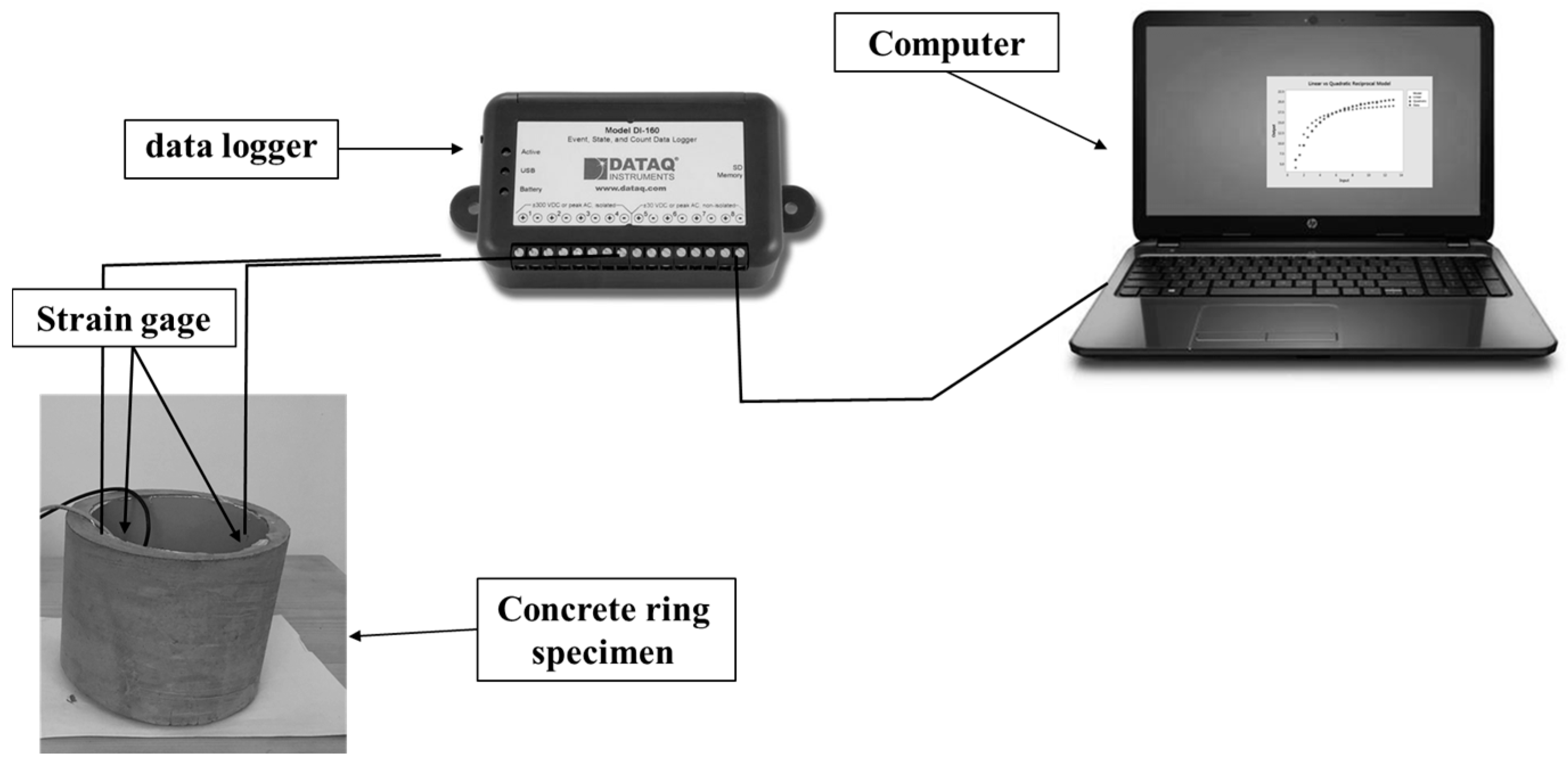

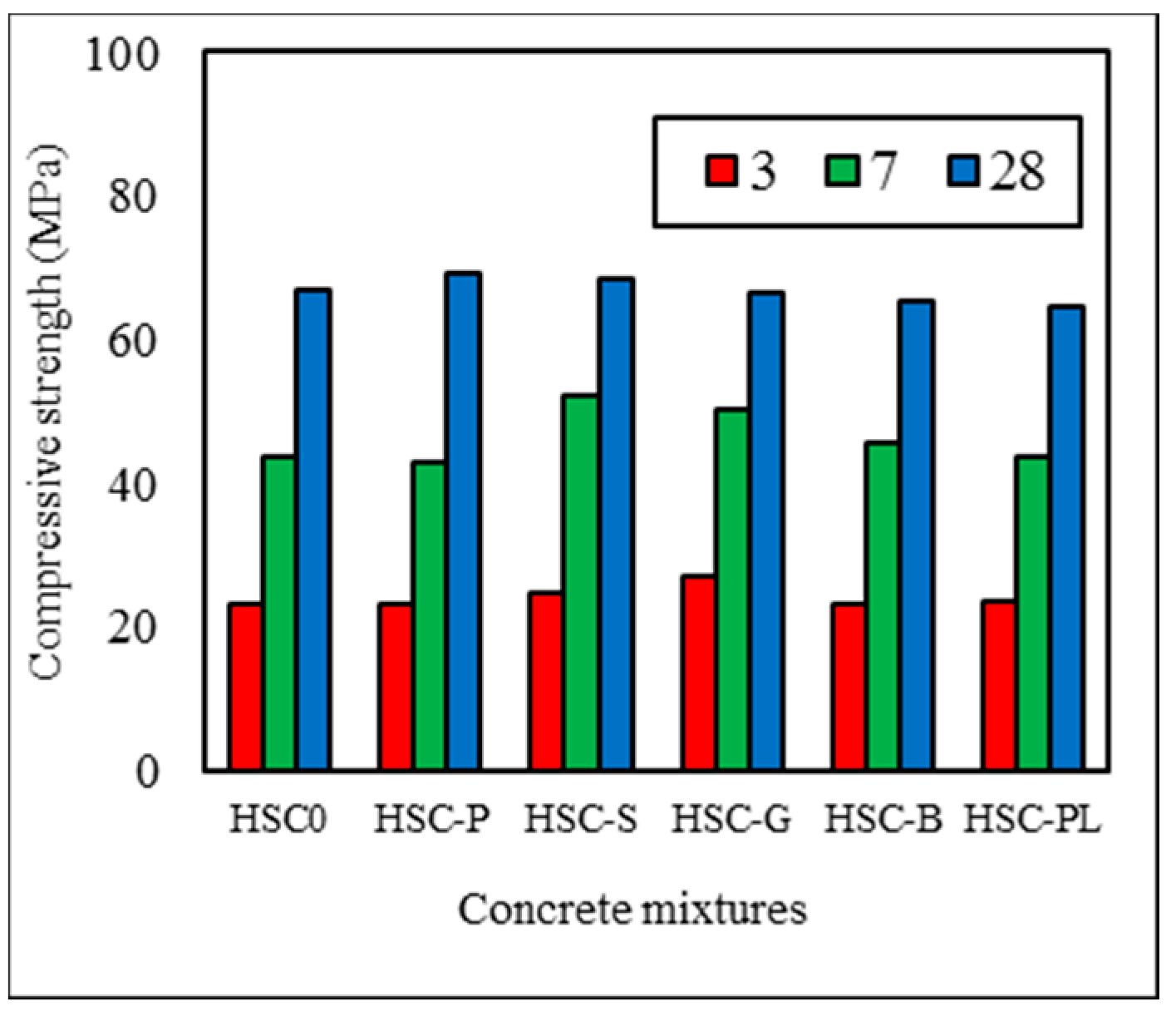
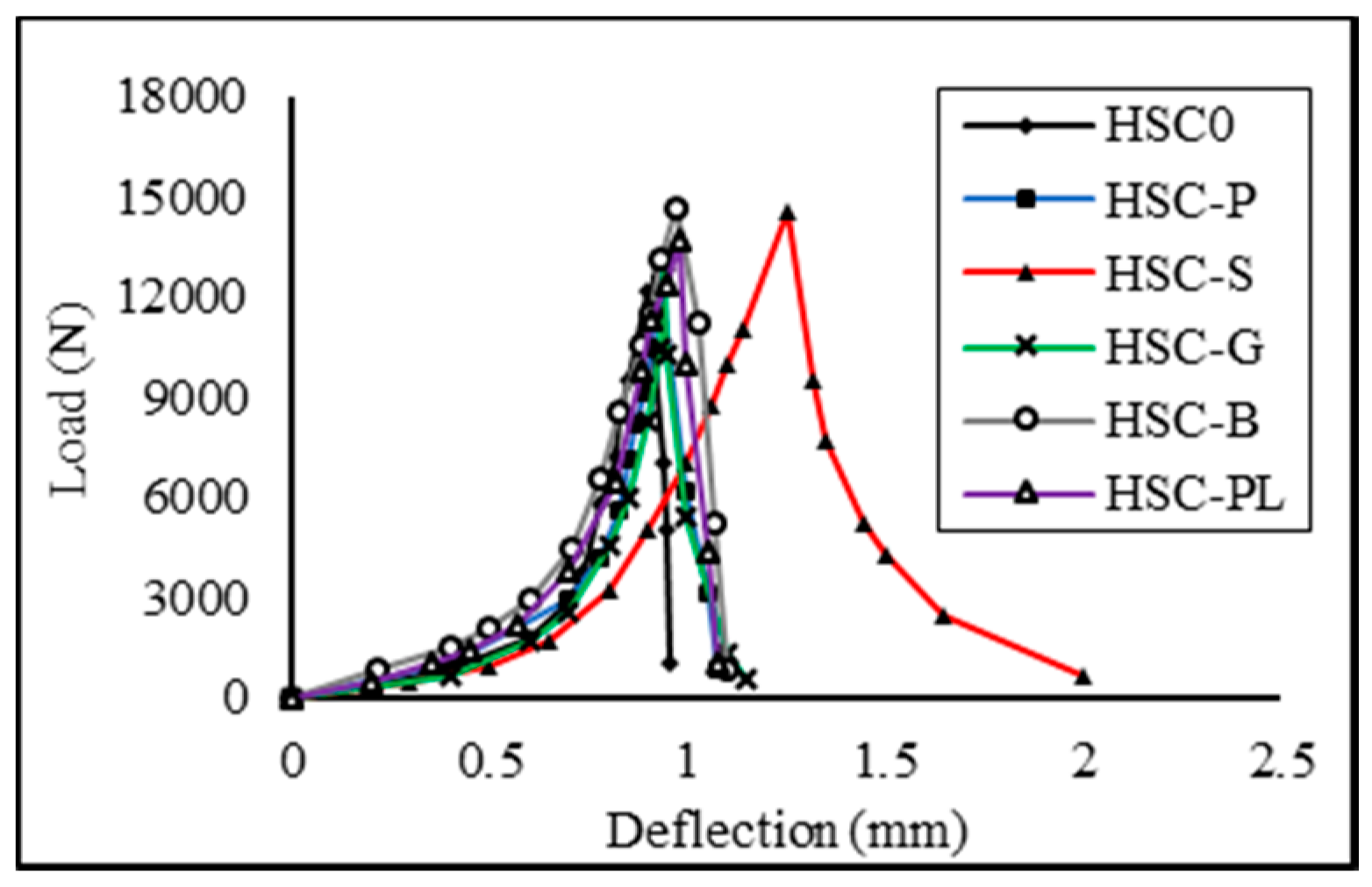
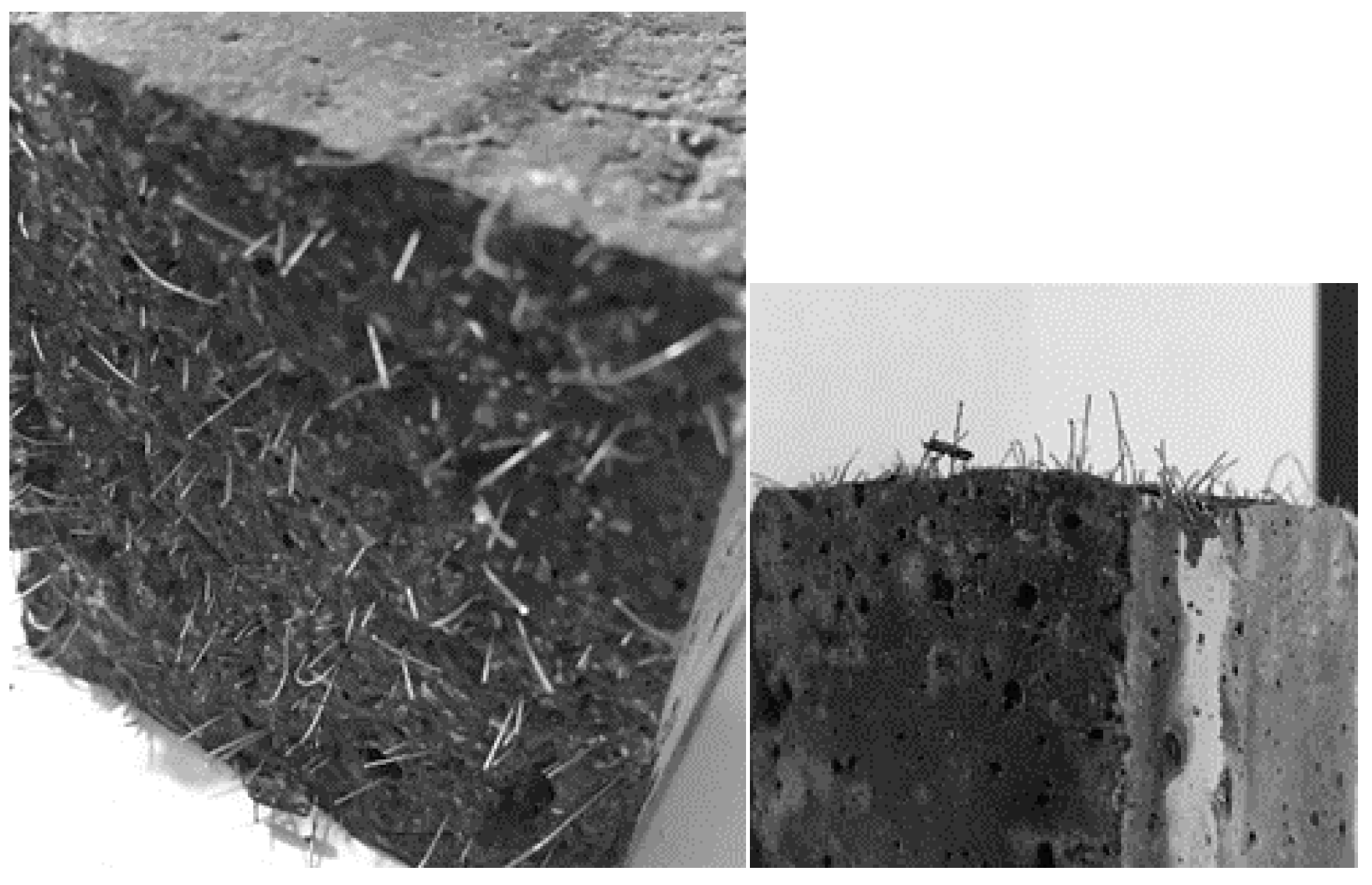

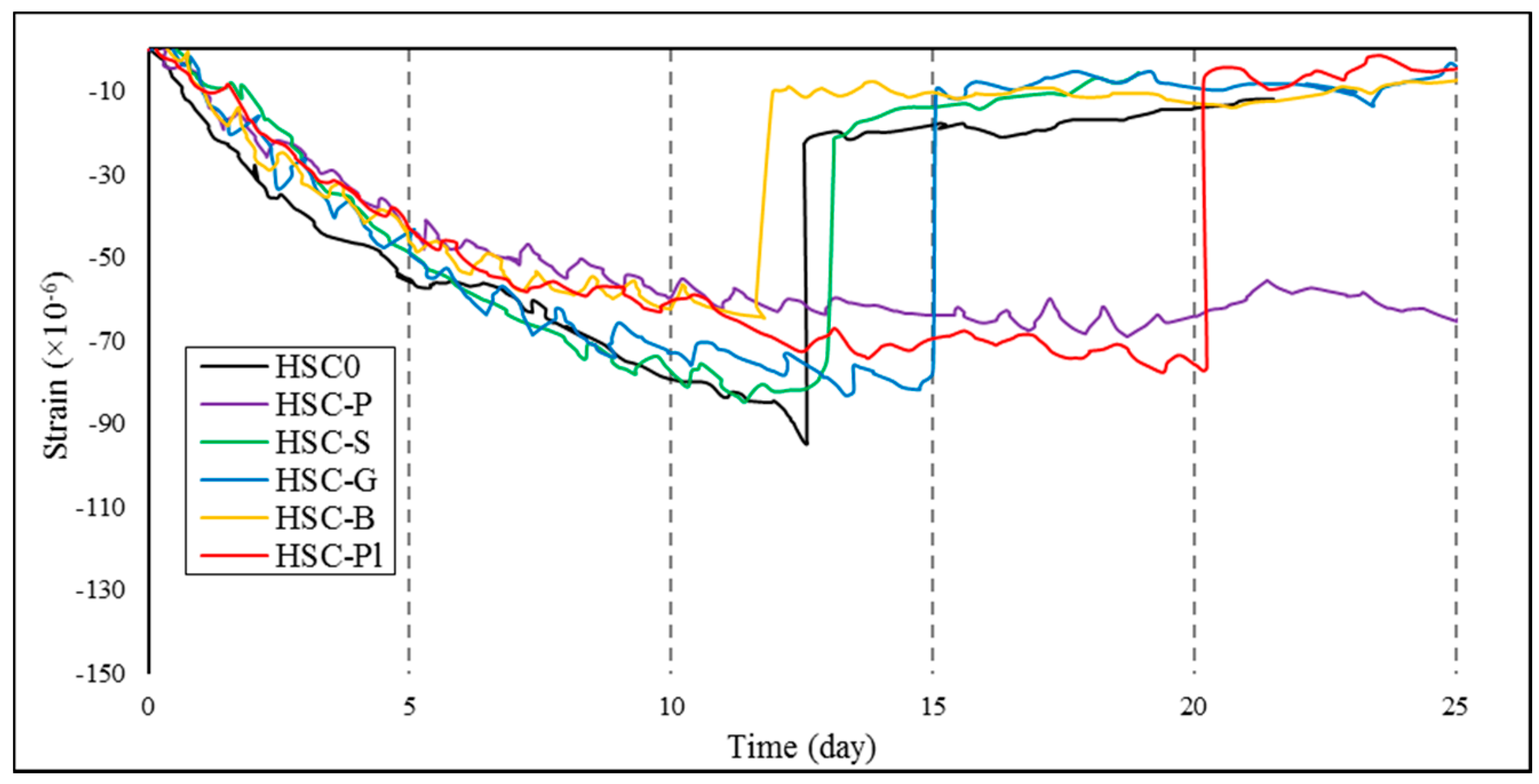

| Materials | Chemical Composition (% by Mass) | |||||||
|---|---|---|---|---|---|---|---|---|
| CaO | SiO2 | Al2O3 | Fe2O3 | MgO | K2O | Na2O | SO3 | |
| Cement | 64.37 | 21.08 | 5.36 | 3.64 | 2 | 0.82 | 0.5 | 2.2 |
| Silica fume | 1.5 | 92 | 1.5 | 2.5 | 2 | - | - | - |
| Fiber Type | Shape | Length (mm) | Diameter (mm) | Density (g/cm3) | Tensile Strength (MPa) | Elasticity Modulus (GPa) |
|---|---|---|---|---|---|---|
| Steel |  | 13 | 0.2 | 7.85 | 1000 | 210 |
| Polypropylene |  | 12 | 0.02 | 0.91 | 451 | 4.5 |
| Glass |  | 12 | 0.012 | 2.7 | 1850 | 65 |
| Basalt |  | 12 | 0.01 | 2.67 | 2100 | 79 |
| Polyolefin |  | 12 | 1.07 | 0.92 | 350 | 6 |
| MIX ID | W/Bi # | Cement | Silica fume | Aggregate | Fibers | ||||||
|---|---|---|---|---|---|---|---|---|---|---|---|
| Fine | Coarse | SP | PP | ST | G | B | P | ||||
| HSC-0 * | 0.38 | 405 | 45 | 781 | 1016 | 2.32 | - | - | - | - | - |
| HSC-P | 0.38 | 405 | 45 | 781 | 1016 | 3 | 0.91 | - | - | - | - |
| HSC-S | 0.38 | 405 | 45 | 781 | 1016 | 2.9 | - | 7.85 | - | - | - |
| HSC-G | 0.38 | 405 | 45 | 781 | 1016 | 2.55 | - | - | 2.7 | - | - |
| HSC-B | 0.38 | 405 | 45 | 781 | 1016 | 2.75 | - | - | - | 2.67 | - |
| HSC-PL | 0.38 | 405 | 45 | 781 | 1016 | 2.65 | - | - | - | - | 1.3 |
| MIX ID | Ultimate Load (KN) | Ultimate Flexural Strength (MPa) | Ultimate Load Deflection (mm) | First Crack Absorbed Energy (KN-mm) | First Crack Toughness (N/mm × 10−4) |
|---|---|---|---|---|---|
| HSC0 | 12.1 | 4.8 | 0.9 | 2.42 | 2419.5 |
| HSC-P | 12.5 | 5 | 0.93 | 2.86 | 2860 |
| HSC-S | 14.6 | 5.84 | 1.25 | 5.3 | 5281.7 |
| HSC-G | 13 | 5.2 | 0.94 | 2 | 1988.1 |
| HSC-B | 14.7 | 5.88 | 0.97 | 4.2 | 4284.6 |
| HSC-PL | 13.7 | 5.48 | 0.98 | 2.4 | 2406.9 |
| MIX ID | Crack Width (mm × 10−2) | Average Crack Age (day) | Full Depth Crack |
|---|---|---|---|
| HSC0 | 41 | 13 | Y |
| HSC-P | 6.5 | 21 | NONE |
| HSC-S | 20 | 11 | Y |
| HSC-G | 45 | 15 | Y |
| HSC-B | 45 | 14 | Y |
| HSC-PL | 40 | 20 | Y |
© 2018 by the authors. Licensee MDPI, Basel, Switzerland. This article is an open access article distributed under the terms and conditions of the Creative Commons Attribution (CC BY) license (http://creativecommons.org/licenses/by/4.0/).
Share and Cite
Saradar, A.; Tahmouresi, B.; Mohseni, E.; Shadmani, A. Restrained Shrinkage Cracking of Fiber-Reinforced High-Strength Concrete. Fibers 2018, 6, 12. https://doi.org/10.3390/fib6010012
Saradar A, Tahmouresi B, Mohseni E, Shadmani A. Restrained Shrinkage Cracking of Fiber-Reinforced High-Strength Concrete. Fibers. 2018; 6(1):12. https://doi.org/10.3390/fib6010012
Chicago/Turabian StyleSaradar, Ashkan, Behzad Tahmouresi, Ehsan Mohseni, and Ali Shadmani. 2018. "Restrained Shrinkage Cracking of Fiber-Reinforced High-Strength Concrete" Fibers 6, no. 1: 12. https://doi.org/10.3390/fib6010012






